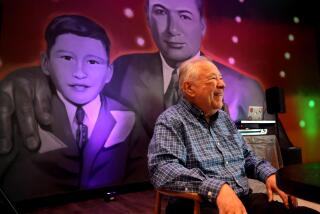Arenas of Conflict : Big Theater Chains, Advocates for the Disabled Clash
Stadium-style movie seating makes Michael Teti furious.
These arenas have aisle stairways leading to seats that rise one row above the next. Major theater chains call them an advance on older movie theaters with improved sight lines and more comfortable seats.
Teti, who has been a disability-rights advocate since multiple sclerosis ended his firefighting career 17 years ago, calls this discrimination.
â[Most] stadium theaters segregate people with mobility impairments to the first row and, sometimes, the back row,â says Teti, who is incensed that AMC is building a stadium-style theater in his neighborhood in Bensalem, Pa. âIf this happened to women or African Americans or Jews, it would never be allowed.â
For years, Teti and other activists have been pushing for movie theater chains to upgrade their facilities to accommodate those with disabilities. Many activists contend theater owners have resisted obvious improvements; theater owners say they are doing the best they can within their means.
Since the Americans with Disabilities Act was passed seven years ago, activists have won several key legal battles against major movie exhibitors.
In 1996, a federal court in California ruled that United Artists Theaters, the nationâs largest chain, had to improve disabled access and disperse wheelchair locations throughout its larger auditoriums. Also, last year, a settlement in Boise, Idaho, required Cineplex Odeon to provide assisted-listening devices for the hearing-impaired in all of its theaters. Advocates for the disabled expected these cases to become models for the industry, but they contend progress has been too slow.
âFor the most part, theater chains have come to realize that complying with the ADA is just good business, but many of them still have a long way to go,â said Liz Savage, a spokeswoman for the U.S. Department of Justice. âSeveral major chains are now under investigation.â
Experts say that disabled-access requirements account for only about a 3% increase in building costs for a new theater. But most exhibitors are grappling with the more difficult economics of bringing existing facilities into compliance.
âIf you take a theater thatâs 60, 70, 80 years old and suddenly youâre required to make it conform to new building codes, the expenses get pretty high,â said UAâs legal counsel, Douglas Wolken. The company has until 2001 to modify 420 theaters under the terms of its settlement.
Common features required by disability-access laws include handicapped parking with a clearly marked, unobstructed access route leading to the entrance, entry and exit ramps, wheelchair seating areas, altered restrooms, widened doorways, and lowered drinking fountains, concession counters, telephones and ticket booths.
Remodeling an average-size theater--with 300 to 500 seats--to meet ADA standards costs about $30,000, experts say.
âTo bring a 1,000-seat theater into compliance, it probably takes a yearâs profit or about $100,000,â says architectural cost estimator Leland Saylor.
Also costly are assisted-listening systems. Toronto-based Cineplex Odeon reports that it spent about $500,000 to install or upgrade this technology at its 800-plus U.S. theaters, to comply with the terms of its settlement.
These systems transmit sound from a theaterâs amplification system via FM radio waves or infrared light. The signal is picked up by special receivers on headsets that are provided to hearing-impaired patrons.
In addition to UA, companies including General Cinema, Cineplex Odeon, Mannâs, Pacific, AMC and Edwards theaters are quick to report that their facilities either meet disability access laws or will be modified.
When changes are not readily achievable--like adding an elevator to a multiplex where the balcony has become a separate auditorium--exhibitors have some alternatives. They can rotate the films or offer the same film at a more accessible theater nearby.
But Oakland attorney Larry Paradis, lead counsel for the plaintiffs in the UA case, is not satisfied. He is preparing to file two class-action lawsuits against âlarge corporations that can well afford to remove barriers.â
âThe theater industry is not being proactive in complying with the ADA. Theyâre waiting to be sued,â Paradis said.
However, PaineWebber media analyst Christopher Dixon argues that financial constraints on the nationâs 30,000-screen theater industry are very real: âSome chains like Cineplex Odeon and UA are still recovering from excesses during the 1980s--such as rapid expansion--when they accumulated high levels of debt.â
The legal fight over disability access to stadium-style theaters will be an interesting test of the disabilities act. The industry claims that these partitioned arenas comply with the ADAâs provisions.
Because steeper stairways have replaced sloped aisles, wheelchair users may have access only to the ground level in smaller theaters. Most larger theaters, with elevator access, also offer seating at the top. But, in both locations, activists say, the view is inferior.
Paradis says that the National Assn. of Theater Operators has manipulated the ADA requirements to serve its own business objectives. He says that the express intent of the ADA was to enable people with disabilities to share equal access with the general audience.
The association âhas tried to misinterpret the Department of Justice statements, they have tried to oppose enforcement of integration standards and have taken the position that encourages their members to disobey ADA requirements,â Paradis said.
But Steven Fellman, counsel for the group, disagrees: The association âtestified in favor of the Americans with Disabilities Act when it was first brought before the Congress . . . and have done all that they can to promote compliance within the motion picture theater industry.â
Some of the new stadium-style mega-plexes have made ADA compliance a selling point to prospective patrons.
Recently, in announcing plans for one of its new facilities, Cineplex Odeon showcased luxury seats, state-of-the-art digital sound, interactive game technology, handicap accessibility and chairs with swing-away arms so that wheelchair patrons can sit comfortably on aisle seats.
Later this year General Cinema will assist researchers from Bostonâs public TV station, WGBH, in testing a system that will enable people who are deaf to experience first-run movies in theaters.
The technology will provide subtitles visible only to those who view the screen through a special visor. It is expected to cost about $10,000 to equip each theater.
(Such technology isnât favored by all disability-rights activists, many of whom are pressing for all films to have subtitles visible without special equipment.)
(BEGIN TEXT OF INFOBOX / INFOGRAPHIC)
Movie-Going Made Easier
Disability-rights activists want movie theater chains to build new facilities and upgrade old ones to accommodate those with disabilities. Theyâve won several court rulings under the Americans With Disabilities Act. Activists say a theater congenial to those with disabilities would contain some of these elements:
TICKET BOOTH
AUDITORIUM
HEADPHONES
A set of headphones with special audio frequencies for the hearing-impaired and another set, with dialogue and visual descriptives, for the blind.
TEXT MONITOR
A small text monitor for the deaf attaches to the armrest of the seat. It can be set level with the movie screen for easier readability.
HOOKUPS
Headphone and text monitor hookups on the side of the armrest are labeled with lighted symbols.
SEATS
Single-armrest seats (armrest missing on aisle side) make it easier to enter from wheelchair.
LEVEL ROW
Level row with lighted guide-lines and empty spaces makes it easy to sit in a wheelchair without rolling.
Source: Americans With Disabilities Act Handbook
Researched by LORENA INIGUEZ / Los Angeles Times
More to Read
The biggest entertainment stories
Get our big stories about Hollywood, film, television, music, arts, culture and more right in your inbox as soon as they publish.
You may occasionally receive promotional content from the Los Angeles Times.










